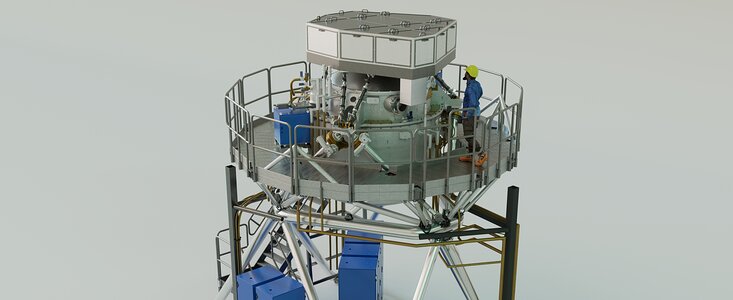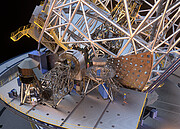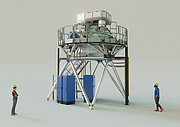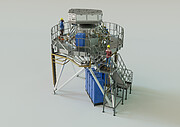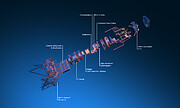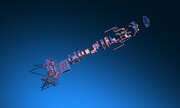Meddelelse
Final design of the ELT's METIS instrument completed
14. maj 2024
The Mid-infrared ELT Imager and Spectrograph, or METIS, has passed its Final Design Review, with ESO now giving the go-ahead on the manufacturing of all instrument components. METIS is a sophisticated multi-tool instrument that will operate on ESO’s upcoming Extremely Large Telescope (ELT). It is the first of the ELT instruments to formally pass its Final Design Review, marking an important step for the METIS consortium, the ELT project, and the instrument-building community.
METIS is a first-generation instrument on the world’s biggest eye on the sky, the ELT, meaning it will start operating when or shortly after the telescope itself starts observing the skies. It has a broad range of science goals, from probing the formation history of our Solar System to peering into the centre of galaxies, to studying their enigmatic supermassive black holes. The main scientific focus of METIS is on the study of planet-forming discs, and recently formed — as well as nearby — exoplanets.
The design process is one step in the journey from a concept to a realised instrument, which takes years to complete for such large, complex, and technologically advanced instruments. METIS passed its first design milestone at its Preliminary Design Review in 2020, while in late 2022, the design of the main instrument components was finalised. Now, with the official completion of the METIS Final Design Review, the consortium can begin the manufacturing phase for all of the instrument’s components. The closure of this review marks the exciting transition from METIS being described in documents to being constructed, assembled and tested.
METIS is designed to observe in the mid-infrared, making it ideal to study cold objects or those enshrouded in dust. While very hot objects at thousands of degrees like our Sun emit mostly visible light, colder ones like planets or dust clouds radiate mostly in the mid-infrared. By analysing light in this frequency range, METIS will study how stars and planets form within dust and gas clouds, and can peer through the dust at the centre of galaxies to study their supermassive black holes. In addition, METIS is expected to make exciting contributions to the field of exoplanets by observing small, rocky exoplanets and investigating the temperature, weather, and chemical composition of their atmospheres in the search for habitable worlds.
METIS is a powerful three-in-one instrument. It has a camera to capture images of the sky, a spectrograph to split the light into its component colours or wavelengths, and its own adaptive optics module to correct for the disrupting turbulence in the atmosphere, working in tandem with the ELT’s adaptive telescope mirrors.The entire instrument will be encased in a cryostat, keeping the instrument at minus 230 degrees Celsius or less so its own heat doesn’t interfere with the infrared measurements.
To learn more about METIS and its people, engineering, and science, watch ‘Meet METIS, a multi-tool instrument for the ELT’.
More Information
The METIS consortium consists of NOVA (Netherlands Research School for Astronomy represented by the University of Leiden, The Netherlands), the Max Planck Institute for Astronomy (MPIA, based in Heidelberg, Germany), the University of Cologne (Germany), the UK Astronomy Technology Centre (UKATC, in Edinburgh, Scotland, UK), the KU Leuven (Belgium), the Paris Saclay research center of the CEA (French Alternative Energies and Atomic Energy Commission, France), Center for Astrophysics and Gravitation (CENTRA, University of Lisbon, Portugal), ETH Zürich (Switzerland), A* (an Austrian partnership represented by the University of Vienna, the University of Innsbruck, the University of Graz, the University of Linz, and RICAM Linz, Austrian Academy of Sciences, Austria), the University of Michigan at Ann Arbor (United States), Academia Sinica Institute of Astronomy and Astrophysics in Taipei (Taiwan), and the Université de Liège (Belgium), with contributions from ESO.
Links
Kontakter
Christoph Haupt
METIS Project Manager at ESO
Cell: +49 151 14176113
Email: Christoph.Haupt@eso.org
Ralf Siebenmorgen
METIS Project Scientist at ESO
Cell: +49 1575 088 6576
Email: Ralf.Siebenmorgen@eso.org
Bernhard R. Brandl
METIS Principal Investigator
Sterrewacht Leiden, Leiden University
Cell: +31 6211 85430
Email: brandl@strw.leidenuniv.nl
Bárbara Ferreira
ESO Media Manager
Garching bei München, Germany
Tel: +49 89 3200 6670
Email: press@eso.org
Om meddelelsen
| Id: | ann24007 |
Our use of Cookies
We use cookies that are essential for accessing our websites and using our services. We also use cookies to analyse, measure and improve our websites’ performance, to enable content sharing via social media and to display media content hosted on third-party platforms.
ESO Cookies Policy
The European Organisation for Astronomical Research in the Southern Hemisphere (ESO) is the pre-eminent intergovernmental science and technology organisation in astronomy. It carries out an ambitious programme focused on the design, construction and operation of powerful ground-based observing facilities for astronomy.
This Cookies Policy is intended to provide clarity by outlining the cookies used on the ESO public websites, their functions, the options you have for controlling them, and the ways you can contact us for additional details.
What are cookies?
Cookies are small pieces of data stored on your device by websites you visit. They serve various purposes, such as remembering login credentials and preferences and enhance your browsing experience.
Categories of cookies we use
Essential cookies (always active): These cookies are strictly necessary for the proper functioning of our website. Without these cookies, the website cannot operate correctly, and certain services, such as logging in or accessing secure areas, may not be available; because they are essential for the website’s operation, they cannot be disabled.
Functional Cookies: These cookies enhance your browsing experience by enabling additional features and personalization, such as remembering your preferences and settings. While not strictly necessary for the website to function, they improve usability and convenience; these cookies are only placed if you provide your consent.
Analytics cookies: These cookies collect information about how visitors interact with our website, such as which pages are visited most often and how users navigate the site. This data helps us improve website performance, optimize content, and enhance the user experience; these cookies are only placed if you provide your consent. We use the following analytics cookies.
Matomo Cookies:
This website uses Matomo (formerly Piwik), an open source software which enables the statistical analysis of website visits. Matomo uses cookies (text files) which are saved on your computer and which allow us to analyze how you use our website. The website user information generated by the cookies will only be saved on the servers of our IT Department. We use this information to analyze www.eso.org visits and to prepare reports on website activities. These data will not be disclosed to third parties.
On behalf of ESO, Matomo will use this information for the purpose of evaluating your use of the website, compiling reports on website activity and providing other services relating to website activity and internet usage.
Matomo cookies settings:
Additional Third-party cookies on ESO websites: some of our pages display content from external providers, e.g. YouTube.
Such third-party services are outside of ESO control and may, at any time, change their terms of service, use of cookies, etc.
YouTube: Some videos on the ESO website are embedded from ESO’s official YouTube channel. We have enabled YouTube’s privacy-enhanced mode, meaning that no cookies are set unless the user actively clicks on the video to play it. Additionally, in this mode, YouTube does not store any personally identifiable cookie data for embedded video playbacks. For more details, please refer to YouTube’s embedding videos information page.
Cookies can also be classified based on the following elements.
Regarding the domain, there are:
- First-party cookies, set by the website you are currently visiting. They are stored by the same domain that you are browsing and are used to enhance your experience on that site;
- Third-party cookies, set by a domain other than the one you are currently visiting.
As for their duration, cookies can be:
- Browser-session cookies, which are deleted when the user closes the browser;
- Stored cookies, which stay on the user's device for a predetermined period of time.
How to manage cookies
Cookie settings: You can modify your cookie choices for the ESO webpages at any time by clicking on the link Cookie settings at the bottom of any page.
In your browser: If you wish to delete cookies or instruct your browser to delete or block cookies by default, please visit the help pages of your browser:
Please be aware that if you delete or decline cookies, certain functionalities of our website may be not be available and your browsing experience may be affected.
You can set most browsers to prevent any cookies being placed on your device, but you may then have to manually adjust some preferences every time you visit a site/page. And some services and functionalities may not work properly at all (e.g. profile logging-in, shop check out).
Updates to the ESO Cookies Policy
The ESO Cookies Policy may be subject to future updates, which will be made available on this page.
Additional information
For any queries related to cookies, please contact: pdprATesoDOTorg.
As ESO public webpages are managed by our Department of Communication, your questions will be dealt with the support of the said Department.
